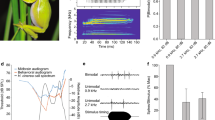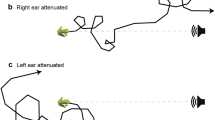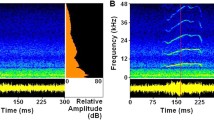Abstract
Ambient noise influences acoustic communication in animals. The concave-eared frogs (Odorrana tormota) produce high-frequency sound signals to avoid potential masking from noise. However, whether environmental noise has effect on the high-frequency hearing of frogs is largely unclear. By measuring the auditory evoked near-field potentials (AENFPs) from the torus semicircularis of the midbrain at frequencies 1–23 kHz in the presence of three noise levels, we found no significant difference in the peak-to-peak amplitude, threshold and latency of AENFP between low-level (35 dB SPL) background noise and mid-level (65 dB SPL) broadcast natural noise. For a natural noise level of 85 dB SPL, AENFP amplitude decreased and threshold and latency increased at frequencies 3–13 kHz. Spike counts evoked by stimuli at the best excitatory frequency under 85 dB SPL natural noise exposure were lower in 7-kHz CF neurons than in exposures to 35 and 65 dB SPL noise. However spike counts were similar for 14- and 20-kHz CF neurons at the three exposure levels. These findings indicate that environmental noise does not mask the responses of high-frequency tuned auditory neurons, and suggest that the acoustic communication system of O. tormota is efficiently adapted to noisy habitats.


Similar content being viewed by others
Abbreviations
- AENFP:
-
Auditory evoked near-field potential
- BEF:
-
Best excitatory frequency
- CF:
-
Characteristic frequency
- RMS:
-
Root mean square
- SNR:
-
Signal-to-noise ratio
- SPL:
-
Sound pressure level
- TS:
-
Torus semicircularis
References
Arch VS, Narins PM (2008) “Silent” signals: selective forces acting on ultrasonic communication systems in terrestrial vertebrates. Anim Behav 76:1423–1428
Arch VS, Grafe TU, Narins PM (2008) Ultrasonic signalling by a Bornean frog. Biol Lett 4:19–22
Brumm H (2004) The impact of environmental noise on song amplitude in a territorial bird. J Anim Ecol 73:434–440
Brumm H, Voss K, Kollmer I, Todt D (2004) Acoustic communication in noise: regulation of call characteristics in a new world monkey. J Exp Biol 207:443–448
Ehret G, Gerhardt H (1980) Auditory masking and effects of noise on responses of the green treefrog (Hyla cinerea) to synthetic mating calls. J Comp Physiol A 141:13–18
Feng AS, Schul J (2007) Sound processing in real-world environments. In: Narins PM, Feng AS, Fay RR, Popper AN (eds) Hearing and sound communication in amphibians. Springer, New York, pp 323–350
Feng AS, Narins PM, Xu CH (2002) Vocal acrobatics in a Chinese frog, Amolops tormotus. Naturwissenschaften 89:352–356
Feng AS, Narins PM, Xu CH, Lin WY, Yu ZL, Qiu Q, Xu ZM, Shen JX (2006) Ultrasonic communication in frogs. Nature 440:333–336
Feng AS, Riede T, Arch VS, Yu ZL, Xu ZM, Yu XJ, Shen JX (2009) Diversity of the vocal signals of concave-eared torrent frogs (Odorrana tormota): evidence for individual signatures. Ethology 115:1015–1028
Francis CD, Ortega CP, Cruz A (2009) Noise pollution changes avian communities and species interactions. Curr Biol 19:1415–1419
Freedman EG, Ferragamo M, Simmons AM (1988) Masking patterns in the bullfrog (Rana catesbeiana). II: physiological effects. J Acoust Soc Am 84:2081–2091
Gerhardt HC, Klump GM (1988) Masking of acoustic signals by the chorus background noise in the green tree frog: a limitation on mate choice. Anim Behav 36:1247–1249
Liu WR, Shen JX, Zhang YJ, Xu ZM, Qi Z, Xue MQ (2014) Auditory sexual difference in the large odorous frog Odorrana graminea. J Comp Physiol A 200:311–316
Morton ES (1975) Ecological sources of selection on avian sounds. Am Nat 108:17–34
Murphy CG, Gerhardt HC (2002) Mate sampling by female barking treefrogs (Hyla gratiosa). Behav Ecol 13:472–480
Narins PM (1982) Effects of masking noise on evoked calling in the Puerto Rican Coqui (Anura: Leptodactylidae). J Comp Physiol A 147:438–446
Narins PM, Wagner I (1989) Noise susceptibility and immunity of phase locking in amphibian auditory-nerve fibers. J Acoust Soc Am 85:1255–1265
Narins PM, Feng AS, Lin WY, Schnitzler HU, Denzinger A, Suthers RA, Xu CH (2004) Old World frog and bird vocalizations contain prominent ultrasonic harmonics. J Acoust Soc Am 115:910–913
Ronacher B, Hoffmann C (2003) Influence of amplitude modulated noise on the recognition of communication signals in the grasshopper Chorthippus biguttulus. J Comp Physiol A 189:419–425
Ryan MJ, Brenowitz EA (1985) The role of body size, phylogeny, and ambient noise in the evolution of bird song. Am Nat 126:87–100
Shen JX, Feng AS, Xu ZM, Yu ZL, Arch VS, Yu XJ, Narins PM (2008) Ultrasonic frogs show hyperacute phonotaxis to female courtship calls. Nature 453:914–916
Shen JX, Xu ZM, Yu ZL, Wang S, Zheng DZ, Fan SC (2011) Ultrasonic frogs show extraordinary sex differences in auditory frequency sensitivity. Nat Commun 2:342. doi:10.1038/ncomms1339
Sinnott JM, Stebbins WC, Moody DB (1975) Regulation of voice amplitude by the monkey. J Acoust Soc Am 58:412–414
Slabbekoorn H, Peet M (2003) Birds sing at a higher pitch in urban noise. Nature 424:267
Slabbekoorn H, Ripmeester EPA (2008) Birdsong and anthropogenic noise: implications and applications for conservation. Mol Ecol 17:72–83
Waser PM, Brown CH (1986) Habitat acoustics and primate communication. Am J Primatol 10:135–154
Witte K, Farris HE, Ryan MJ, Wilczynski W (2005) How cricket frog females deal with a noisy world: habitat-related differences in auditory tuning. Behav Ecol 10:571–578
Wollerman L (1999) Acoustic interference limits call detection in a Neotropical frog Hyla ebraccata. Anim Behav 57:529–536
Yu ZL, Qiu Q, Xu ZM, Shen JX (2006) Auditory response characteristics of the piebald odorous frog and their implications. J Comp Physiol A 192:801–806
Zelick R, Mann DA, Popper AN (1999) Acoustic communication in fishes and frogs. In: Fay RR, Popper AN (eds) Comparative hearing: fish and amphibians. Springer, New York, pp 363–411
Acknowledgments
This work was supported by the grants from the National Natural Science Foundation of China (No. 30730029 to JXS; No. 31270891 to ZQ) and from the Chinese Academy of Sciences (Y3CQ031001 to JXS). All experiments were conducted following the Animal Care and Use Guidelines approved by the Xiamen University and the Institute of Biophysics, Chinese Academy of Sciences.
Author information
Authors and Affiliations
Corresponding author
Ethics declarations
Conflict of interest
The authors declare that they have no conflict of interest.
Ethical standard
The ethical standards of the experiments comply with the current laws of the country in which they were performed.
Rights and permissions
About this article
Cite this article
Liu, J., Yang, H., Hu, GL. et al. Little effect of natural noise on high-frequency hearing in frogs, Odorrana tormota . J Comp Physiol A 201, 1029–1034 (2015). https://doi.org/10.1007/s00359-015-1035-2
Received:
Revised:
Accepted:
Published:
Issue Date:
DOI: https://doi.org/10.1007/s00359-015-1035-2




